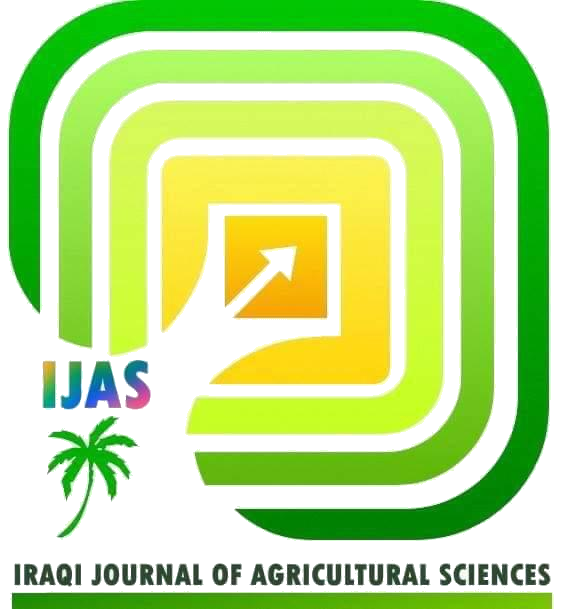PREDICTING MILK PRODUCTION AND ITS COMPONENTS BY LACTOFERRIN CONCENTRATION IN COLOSTRUM AND MILK OF HOLSTEIN COWS
DOI:
https://doi.org/10.36103/8df2fz29Keywords:
prediction, milk, colostrum, lactoferrin, holstein cows.Abstract
The objective of this study was to predict the milk yield and its constituents of first parity-ten Holstein cows through lactoferrin concentration in colostrum and milk. The study was executed at Al-Nasr Dairy Cattle Station, at Essaouira (50 km south of Baghdad) during the period from 15/1/2013 to 1/4/2013. The lactoferrin concentration in colostrum and milk, milk constituents and the minerals concentration were measured. The lactoferrin concentration in colostrum was 732.78+ 28.03mg/L, which was higher than its concentration in milk (541.11+ 19.20 mg/L). Milk constituents (fat, protein and lactose) and some minerals (calcium, phosphorus and magnesium) were greater in colostrum than in milk. The regression of daily and monthly milk yield on lactoferrin concentration in colostrum was positive and highly significant (P<0.01), while the regression of these characters on lactoferrin concentration in colostrum was positive and significant (P<0.05). Result revealed that the regression of minerals (calcium and magnesium) on lactoferrin in colostrum was positive and highly significant (P<0.01). Moreover, the regression of phosphorus and iron in colostrum was negative and significant (P<0.05). The regression relationship of amino acids (essential and non-essential) on lactoferrin in colostrum was varied between positive and negative and some of them was significant. In conclusion, it is possible to predict the milk yield and its constituents of Holstein cows through lactoferrin concentrations either in milk of colostrum for selection purposes.
References
1. Baker, E.N. 1994. Structure and reactivity of transferrin .Advances Inorganic Chemistry,41:389-463.
2. Ionysius,D.A.; P.A Grieve,. and J.M. Milne, 1993.Forms of lactoferrin: Their antbacterial effect on enterotoxigenic Escherichia coli.Journal of dairy Science, 76:2597-2606
3. Feng, S.,Loke,A.,and P.C. Garnsworthy. 2004. Avoid method for determing amino acid compostion of milk .J.Dairy Sci., 87:3735-3788
4. Fonteh, F. A., A. S. Grandison, and M. J. Lewis. 2002. Variations of lactoperoxidase activity and thiocyanate content in cows’ and goats’ milk throughout lactation. J. Dairy Res. 69:401–409
5. Flores-Villasenor, He.;Canizalez-Roman, A. and M Reyes-Lopz,. 2010. Bactericidal effect of bovine lactoferrin, LFcin, LFampin and LFchimera on antibiotic –resistant Staphylococcusaureus and Escherichia coli .Biometals,23:569-578
6. Gifford, J.L; H.N. Hunter and H.J Vogel,. 2005. Lactoferricin: a lactoferrin– derived peptide with antimicrobial, antiviral, antitumor and immunological properties.Cellular and Molecular Life Sciences, 62(22): 2588-2589.
7. Huang, S.W.;Satue – T.Gracia; E.N.Frankel, and D. Germa, 1999.Effect of lactoferrin on antioxidive stability of corn oil emulsions and liposomes. J.Agric. Food Chem, 47(4):1356-1361.
8. Hwang,p.M.;XI-An,N.Z; C.H.Arrow, and H.J. Vogel, 1998. Three-dimensional solution structure of lactoferricin B, an antimicrobial peptide derived from bovine lactoferrin Biochemistry,37(12) 4288- 4298
9. Jenssen, H.and R.E. Hancock, 2009.Antimacrobail properties of lactoferrin. Biochimie, 91:91-29
10. McDowell, L. R., and J. D. Arthington. 2005. Minerals for Grazing Ruminants in Tropical regions. 4th ed. University of Florida, IFAS, Gainesville.pp:1-86
11. Moore, S. A. B. F. Anderson; C.R Groom, M. Haridas, and E. N. Baker. 1997. Three – dimensional structure of diferric bovine lactoferrin At 2. 8. A resolution J. Mol. Biol, 274: 222:236
12. Miller,N.J.Sampson, L.P. Candeiaias, P.M. Bramlery and C.A. Rice-Evans, 1992.Antioxidant activates of carotenes and xanthophyll's, FEBS Lett., 384-:240-242
13. Rainard, P, and C. Riollet. 2006. Innate immunity of the bovine mammary gland. Vet. Res. 37:369–400
14. Richards, L. A. 1954. Diagnosis and improvent of Saline and Alkaline Soils, USDA.Handbook 60 USDA,Washington DC
15. SAS. 2010. SAS/Statistical Analysis System User’s Guide. Statistical. Version 9.1th ed. SAS. Institute Inc. Cary. N. C, USA.
16. Spears JW, WP Weiss. 2008. Role of antioxidants and trace elements in health and immunity of transition dairy cows. Vet J 176, 70-76
17. Underwood, E. J., and N. F. Suttle. 1999. The Mineral Nutrition Livestock. 3rd ed. CABI Publishing, New York, NY.
18. Van der Kraan, M. L; Groenink; K. Nazmi; E. C.Veerman, J. G. Bolscher, and A.V Nieuw. 2004. Lactoferrampin: Anovel antimicrobial peptide in the N1-domain of bovine lacto ferrin. peptides. 25: 177-183
19. Vorbach,C; M.R.Capecchi, and J.M. Penninger, 2006. Evaluation of the mammary gland from the innate immune system? Bioassys, 28, 606 – 616.
Downloads
Published
Issue
Section
License
Copyright (c) 2025 IRAQI JOURNAL OF AGRICULTURAL SCIENCES

This work is licensed under a Creative Commons Attribution-NonCommercial 4.0 International License.

2.jpg)
 https://orcid.org/0000-0002-5774-5906
https://orcid.org/0000-0002-5774-5906 



